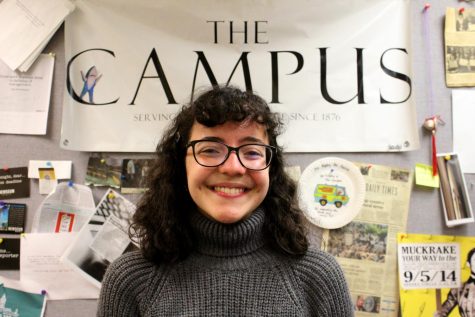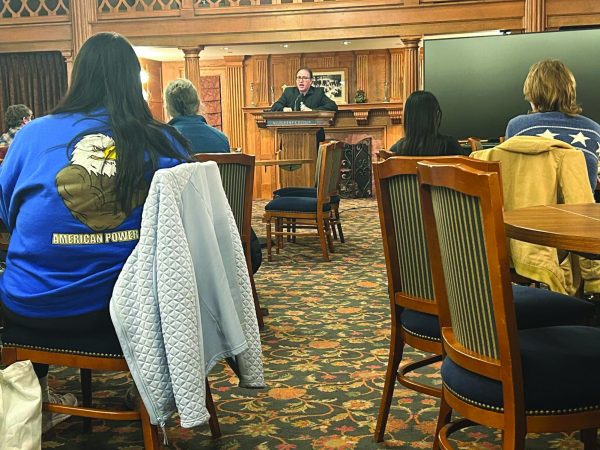Local graveyard brimming with history
The journey from Allegheny College to Greendale Cemetery is approximately three minutes by car and 20 minutes by foot. Some corners of the campus community take advantage of this proximity. For instance, the “Overkill” literary magazine invites writers there around Halloween to pen stories amid the graves. In addition, the history and philosophy departments sponsored a tour on Friday, Oct. 28, at 4 p.m. The tour, conducted by historian Ron Maddox, covered not only Greendale but also the nearby Hebrew Cemetery, where Meadville’s Jewish history can be seen.
In spite of these efforts to introduce members of the college to its grounds, the cemetery remains shrouded in some mystery, and this issue of sorts extends beyond Allegheny into the broader Meadville community. For one thing, it was designed not only as a place to bury those who have passed, but also as a park, complete with walking trails.
To comprehend the cemetery as it stands today, a brief history of interring Meadville’s dead is required. The cemetery’s website explains that in 1811, Meadville founder David Mead deeded land on the corner of Park Avenue and Randolph Street to the Presbyterian Church, and two years later a fence surrounded the area.
“At that time, it cost $0.50 to bury an adult, $0.25 for a child, and $1.00 for a ‘stranger,’” the website says.
By the mid-1800s it was time for a change, not only due to the small piece of land but also its location in the center of the growing downtown area. Randolph Street Cemetery’s remains were disinterred and transported to what is now known as Greendale Cemetery.
“Though (these remains) were placed in one large grave, the individual grave markers were also moved and may be found in a central section of Greendale,” the website writes.
The cemetery also serves as the final resting place for locally famous individuals, such as Mead himself — apparently.
“They had to move his grave from town up to the cemetery there when you weren’t allowed to have graves in town anymore,” said Professor of Communication Arts Michael Keeley. “It might not be him, because the nails that are in that coffin are too new.”
What is certain, however, is that two Civil War veterans buried on Greendale’s grounds served as bodyguards for Abraham Lincoln.
*
Aside from teaching, Keeley also makes films with an emphasis on local subjects. When looking for an idea for a new production, Keeley turned to the cemetery that is part of the town.
“I just thought it would be a nice experience to try and capture the beauty of the place,” Keeley said. “What I discovered when I was making the film, too, was how much work goes into keeping it beautiful.”
Along the way Keeley became acquainted with Jim and Mary Vogan, who raised their family on the property and cared for the grounds for almost forty years. They became the story, in addition to the cemetery.
Keeley’s documentary,“This is a Cemetery,” as well as a series of photos from the showing on Feb. 28, 2019, can be viewed on the Greendale Cemetery website. A second viewing had to be added that evening due to the unexpected number of moviegoers who flocked to Park Avenue Cinema, eager to remove the veil of unfamiliarity from this graveyard.
*
In spite of Greendale’s lengthy history, only 12 individuals have served as superintendent, digging graves, caring for the grounds and ensuring the cemetery is running efficiently. The most recent edition in this line is Jim and Mary Vogan’s nephew Patrick Groover, who explained that when people learn of his job, they are not so much spooked by what it entails as by where he lives on account of said job. He resides in the caretaker’s house, which is located on the grounds and was originally meant for the sexton but redesignated for the superintendent in 1875.
“They always ask me if I’ve seen ghosts and stuff,” Groover said. “I’ve never seen any ghosts, so can’t really tell them that … I don’t find it creepy.”
Groover has been working at Greendale Cemetery since 2006, when he was 15 years old, but last year, when Jim Vogan retired, he assumed the superintendent position. Being around the graveyard for this length of time, he said, has lessened his sensitivity towards death somewhat, since he is focused on the tasks at hand, but he does get emotional when people visit their loved ones who have died.
“It’s just that I see a different side than most people,” Groover added. “(The experience) changed it a little bit, but there’s still the emotional factor.”
Being relatively new to the superintendent role, Groover said he did not have many interesting cemetery stories yet, aside from occasionally having to catch people wandering the grounds past closing time. He added that his uncle Jim, who was no stranger to this problem himself, had a dog who would chase the kids trespassing in the early hours of the morning.
*
“Lives are commemorated – deaths are recorded – families are reunited – memories are made tangible – and love is undisguised.
“This is a cemetery.”
So begins a passage, titled “This is a Cemetery,” utilized by cemeteries around the world either on their websites, on their grounds, or both, as is the case with Greendale. Mary Lou Brannon is believed to have written this passage, though she is rarely credited — oftentimes the author is listed as “anonymous” or “unknown.” Not knowing for sure who penned these words, however, does not detract from their salience.
As Stoness Family Funeral Home in Alabama writes on its website, “This poem, in a few short lines, manages to convey all the reasons why cemeteries are so important, especially for the living.”
Enter Greendale Cemetery through the archway and you will soon find the work in its entirety carved out in stone.

Sofia Hassan is a second-year student from New Castle, Pennsylvania. She plans to major in English Creative Writing and minor in Middle East and North...







